
Sudi
Encyclopedia
Sudi is a panchayat town in the Gadag District
of Karnataka
, India
. It is about 30 km from Badami
, 12 km from Gajendragad and 3 km from Itagi Bhimambika
temple. In the past it was a important town of the Kalyani Chalukyas during 1000 AD. It is famous for rare stone carved monuments like Twin towered temple, Mallikarjuna temple and nagakunda (large well built of stone and carvings), and few other structural temples. For long time these amazing structures were abandoned, but recently they caught the eye of the Indian Archaeological Department (ASI - Archaeological Survey of India
).

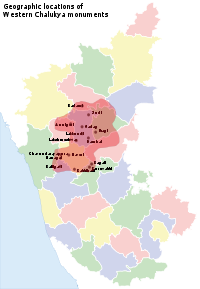 Sudi belongs to the core area of Western Chalukya architectural activity in modern Karnataka
Sudi belongs to the core area of Western Chalukya architectural activity in modern Karnataka
(Perticularly North Karnataka
).
Padevala Taila (son of Nagadeva), continued to serve under Satyasraya (succeeded his father Taila in 997 AD) and his mother Attiyabbe made a grant in 1005 A.D. Satyasraya had two daughters. Vradhamabbarasi and Akkadevi and one son Kundin
(Kundiraja). Akkadevi was a good administrator and was governing some division
during the time of Satyasraya and his successors. Kundiraja was placed in charge of divisions like Banavasi
12,000 and Santalige 1,000.
Akkadevi and Kundin, continued to govern ( dating October 8, 1013 AD) some provinces of the Chalukya Empire during the reign of Vikramaditya
.
Sudi was the capital of the Kalyani Chalukyas in 1100 AD. Kalyani Chalukyas king's daughter Akkadevi ruled the place. There are also historical records indicating that coins were manufactured (mint) in this town during that time.
(973 – 1189 south), The Alupas
, a feudatory, minted coins with the Kannada and Nagari legend Sri Pandya Dhanamjaya. Lakkundi
and Sudi in Gadag district
were the main mints (Tankhashaley) .
Their heaviest gold coin was Gadyanaka(weighting 96 grains), Dramma (weighted 65 grains), Kalanju
(48 grains), Kasu (15 grains), Manjadi (2.5 grains), Akkam (1.25 grains) and Pana (9.6 grain).
gain importance and Jainism
lost towards the closing years of the Chalukya rule. Shaivism was dominant, had several sects like Shaiva, Pasupata or Lakula, Kalamukha and Kapaliaka. The Pasupata school was important which had important centers at Balligavi
, Sudi, Srisailam
and other places.
their women and sacked and have burnt Mannandippai. The Chalukya reverses are admitted in a Sudi inscription, dated in 1050 A.D., of the reign of Somesvara. It says that the 7 ministers granted the settis renewal of their corporate constitution ( which had partly broken down in the stress of the war with the Cholas).
The Chola king was killed at Koppam, but the Chalukyas were also pushed back from
there by Rajendra. Soon after the Chalukyas raided Kanchi, the Chola capital,
burnt the city and defeated the Cholas once again. A Sudi inscription (Thursday, January 20, 1060 AD), records that king Trailokyamalla was halting at his camp Puli, a town within Sindavadi division after having made a victorious expedition to the southern region and conquered the Chola.
Sudi has several stone temples built by Maha Samanthadhipati Naga Deva in 1100 AD. that have caught the attention of Karnataka
State Archeological Department. Quite a few of these structures have been cleaned up. Besides age old structures there is also a tower (called Hude in native language) located in the center of the village. The richness of these temples can be viewed in the images posted here.
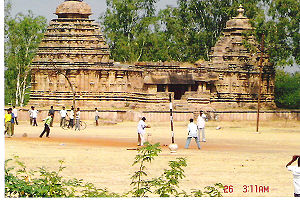 Twin Towered , Two Vimana, Jodakalasa Temple
Twin Towered , Two Vimana, Jodakalasa Temple
Later Chalukya monument, Before 1059-60, by Nageshwara by General Nagadeva administering Sudi.
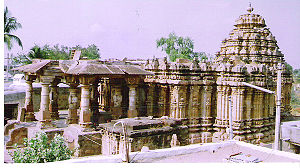 Mallikarjuna temple at Sudi is a later Chalukya (Kalyani Chalukyas) monument, 1054, Founded under princess Akkadevi Governor of Sudi
Mallikarjuna temple at Sudi is a later Chalukya (Kalyani Chalukyas) monument, 1054, Founded under princess Akkadevi Governor of Sudi
 Nagakunda literally means King cobra tank at Sudi is a beautifully carved (Inner wall) temple tank. This is most beautiful temple tank in the North Karnataka
Nagakunda literally means King cobra tank at Sudi is a beautifully carved (Inner wall) temple tank. This is most beautiful temple tank in the North Karnataka
.
This is totally neglected by the people, ASI and Govt. of Karnataka
.
There is need of immediate conservation work to protect this monument.
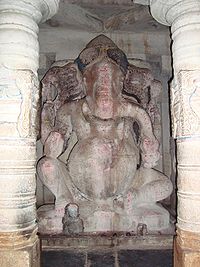


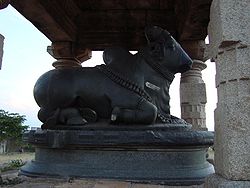
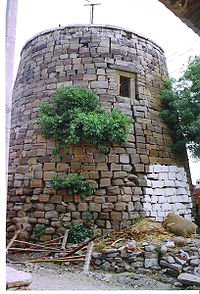 At Sudi you can notice so many other monuments like Large beautiful Ganapati Statue and Nandi statue in side mantapa, Large shiva linga etc.
At Sudi you can notice so many other monuments like Large beautiful Ganapati Statue and Nandi statue in side mantapa, Large shiva linga etc.
It is located 120 kilometres from Karnataka, 42 kilometres from Gadag and 450 kilometres from Bangalore
, the state capital.
The temperature ranges from minimum 23 degrees to 45 degrees during summer and from 15 to 29 degrees in winter. The rainfall of the area is 50 centimeters. Best time to visit is between low humid season from November and March.
, Sudi had a population of 6,000. Males constitute 51% of the population and females 49%. Sudi has an average literacy rate of 65%, higher than the national average of 59.5%; with 59% of the males and 41% of females literate. 14% of the population is under 6 years of age.
|-
!
|-
|style="text-align: center; width: 100%; " |
Gadag District
Gadag District had a population of 971,952 of which 35.21% was urban as of 2001. Population increased 13.14% in the decade 1991-2001. The District is bounded on the north by Bagalkot District, on the east by Koppal District, on the southeast by Bellary District, on the southwest by Haveri...
of Karnataka
Karnataka
Karnataka , the land of the Kannadigas, is a state in South West India. It was created on 1 November 1956, with the passing of the States Reorganisation Act and this day is annually celebrated as Karnataka Rajyotsava...
, India
India
India , officially the Republic of India , is a country in South Asia. It is the seventh-largest country by geographical area, the second-most populous country with over 1.2 billion people, and the most populous democracy in the world...
. It is about 30 km from Badami
Badami
Badami , formerly known as Vatapi, is a town and headquarters of a taluk by the same name, in the Bagalkot district of Karnataka, India. It was the regal capital of the Badami Chalukyas from 540 to 757 AD. It is famous for rock cut and other structural temples...
, 12 km from Gajendragad and 3 km from Itagi Bhimambika
Itagi Bhimambika
Itagi, small temple town in North Karnataka, It is famous for the temple of Bheemavva or BhimambikaIt is in Gadag District, Ron Taluk in Karnataka, India. About 13 km from Gajendragad Kalkaleshwara temple. Hundreds and thousands of...
temple. In the past it was a important town of the Kalyani Chalukyas during 1000 AD. It is famous for rare stone carved monuments like Twin towered temple, Mallikarjuna temple and nagakunda (large well built of stone and carvings), and few other structural temples. For long time these amazing structures were abandoned, but recently they caught the eye of the Indian Archaeological Department (ASI - Archaeological Survey of India
Archaeological Survey of India
The Archaeological Survey of India is a department of the Government of India, attached to the Ministry of Culture . The ASI is responsible for archaeological studies and the preservation of archaeological heritage of the country in accordance with the various acts of the Indian Parliament...
).

History

Karnataka
Karnataka , the land of the Kannadigas, is a state in South West India. It was created on 1 November 1956, with the passing of the States Reorganisation Act and this day is annually celebrated as Karnataka Rajyotsava...
(Perticularly North Karnataka
North Karnataka
North Karnataka is an arid plateau from elevation in the Karnataka state of southwest India. It is drained by the Krishna River and its tributaries the Bhima, Ghataprabha, Malaprabha, and Tungabhadra...
).
Padevala Taila (son of Nagadeva), continued to serve under Satyasraya (succeeded his father Taila in 997 AD) and his mother Attiyabbe made a grant in 1005 A.D. Satyasraya had two daughters. Vradhamabbarasi and Akkadevi and one son Kundin
(Kundiraja). Akkadevi was a good administrator and was governing some division
during the time of Satyasraya and his successors. Kundiraja was placed in charge of divisions like Banavasi
Banavasi
Banavasi is an ancient temple town in Uttara Kannada District bordering Shivamogga district in the South Indian state of Karnataka .-History:Banavasi is one of the oldest towns in the Karnataka state...
12,000 and Santalige 1,000.
Akkadevi and Kundin, continued to govern ( dating October 8, 1013 AD) some provinces of the Chalukya Empire during the reign of Vikramaditya
Vikramaditya
Vikramaditya was a legendary emperor of Ujjain, India, famed for his wisdom, valour and magnanimity. The title "Vikramaditya" was later assumed by many other kings in Indian history, notably the Gupta King Chandragupta II and Samrat Hem Chandra Vikramaditya .The name King Vikramaditya is a...
.
Sudi was the capital of the Kalyani Chalukyas in 1100 AD. Kalyani Chalukyas king's daughter Akkadevi ruled the place. There are also historical records indicating that coins were manufactured (mint) in this town during that time.
Coinage
During Western ChalukyasWestern Chalukyas
The Western Chalukya Empire ruled most of the western Deccan, South India, between the 10th and 12th centuries. This dynasty is sometimes called the Kalyani Chalukya after its regal capital at Kalyani, today's Basavakalyan in Karnataka and alternatively the Later Chalukya from its theoretical...
(973 – 1189 south), The Alupas
Alupas
The Alupas kings were a minor dynasty who ruled parts of coastal Karnataka. Later with the dominance of Kadambas in Banavasi, they became feudatory to them. With the changing political scenario, soon they became the feudatories to Chalukyas, Hoysalas and Vijayanagara Rayas...
, a feudatory, minted coins with the Kannada and Nagari legend Sri Pandya Dhanamjaya. Lakkundi
Lakkundi
Lakkundi in Gadag District of Karnataka is a tiny village on the way to Hampi from Hubli. Lakkundi 11 km from Gadag in the east...
and Sudi in Gadag district
Gadag District
Gadag District had a population of 971,952 of which 35.21% was urban as of 2001. Population increased 13.14% in the decade 1991-2001. The District is bounded on the north by Bagalkot District, on the east by Koppal District, on the southeast by Bellary District, on the southwest by Haveri...
were the main mints (Tankhashaley) .
Their heaviest gold coin was Gadyanaka(weighting 96 grains), Dramma (weighted 65 grains), Kalanju
(48 grains), Kasu (15 grains), Manjadi (2.5 grains), Akkam (1.25 grains) and Pana (9.6 grain).
Shaivism, Pasupata school
ShaivismShaivism
Shaivism is one of the four major sects of Hinduism, the others being Vaishnavism, Shaktism and Smartism. Followers of Shaivism, called "Shaivas," and also "Saivas" or "Saivites," revere Shiva as the Supreme Being. Shaivas believe that Shiva is All and in all, the creator, preserver, destroyer,...
gain importance and Jainism
Jainism
Jainism is an Indian religion that prescribes a path of non-violence towards all living beings. Its philosophy and practice emphasize the necessity of self-effort to move the soul towards divine consciousness and liberation. Any soul that has conquered its own inner enemies and achieved the state...
lost towards the closing years of the Chalukya rule. Shaivism was dominant, had several sects like Shaiva, Pasupata or Lakula, Kalamukha and Kapaliaka. The Pasupata school was important which had important centers at Balligavi
Balligavi
Balligavi a town in Shikaripura taluk Shimoga district of Karnataka state, India, is today known as Belagami or Balagame. Its ancient names are Dakshina Kedara,Valliggame and Valligrame. Dakshina Kedara means Kedarnath of the South. A place of antiquity, it is known for its ancient monuments...
, Sudi, Srisailam
Srisailam
Srisailam is a holy town and mandal, situated in Nallamala Hills of Kurnool district, Andhra Pradesh, India. It is located on the banks of River Krishna, about 232 km south of Hyderabad....
and other places.
Inscriptions
The Cholas claim to have captured a large number of Chalukya feudatory princes withtheir women and sacked and have burnt Mannandippai. The Chalukya reverses are admitted in a Sudi inscription, dated in 1050 A.D., of the reign of Somesvara. It says that the 7 ministers granted the settis renewal of their corporate constitution ( which had partly broken down in the stress of the war with the Cholas).
The Chola king was killed at Koppam, but the Chalukyas were also pushed back from
there by Rajendra. Soon after the Chalukyas raided Kanchi, the Chola capital,
burnt the city and defeated the Cholas once again. A Sudi inscription (Thursday, January 20, 1060 AD), records that king Trailokyamalla was halting at his camp Puli, a town within Sindavadi division after having made a victorious expedition to the southern region and conquered the Chola.
Sudi has several stone temples built by Maha Samanthadhipati Naga Deva in 1100 AD. that have caught the attention of Karnataka
Karnataka
Karnataka , the land of the Kannadigas, is a state in South West India. It was created on 1 November 1956, with the passing of the States Reorganisation Act and this day is annually celebrated as Karnataka Rajyotsava...
State Archeological Department. Quite a few of these structures have been cleaned up. Besides age old structures there is also a tower (called Hude in native language) located in the center of the village. The richness of these temples can be viewed in the images posted here.
Twin Towered Shiva Temple

Later Chalukya monument, Before 1059-60, by Nageshwara by General Nagadeva administering Sudi.
Mallikarjuna Temple

Naga Kunda (Well)

North Karnataka
North Karnataka is an arid plateau from elevation in the Karnataka state of southwest India. It is drained by the Krishna River and its tributaries the Bhima, Ghataprabha, Malaprabha, and Tungabhadra...
.
This is totally neglected by the people, ASI and Govt. of Karnataka
Karnataka
Karnataka , the land of the Kannadigas, is a state in South West India. It was created on 1 November 1956, with the passing of the States Reorganisation Act and this day is annually celebrated as Karnataka Rajyotsava...
.
There is need of immediate conservation work to protect this monument.
Other monuments at Sudi



- Large Ganapati Statue
- Ishwara Linga in a stone made shelter
- Large Shiva linga
- Hude (Tower)


Geography
Sudi is located at 15.73°N 75.865°EIt has an average elevation of 586 metres (1922 feet). It is located adjacent to a 2 streams called Hirehalla and Doddahalla and has total area of the town is 5.3 square kilometres.It is located 120 kilometres from Karnataka, 42 kilometres from Gadag and 450 kilometres from Bangalore
Bangalore
Bengaluru , formerly called Bengaluru is the capital of the Indian state of Karnataka. Bangalore is nicknamed the Garden City and was once called a pensioner's paradise. Located on the Deccan Plateau in the south-eastern part of Karnataka, Bangalore is India's third most populous city and...
, the state capital.
Climate
- Summer - March to June
- Spring - Jan to March
- Monsoons - July to October that contributes to rainfall
- Winter - November to Jan
The temperature ranges from minimum 23 degrees to 45 degrees during summer and from 15 to 29 degrees in winter. The rainfall of the area is 50 centimeters. Best time to visit is between low humid season from November and March.
Transport
The nearest airport is Hubli about 100 kilometres away. It is east of Hubli-Sholapur rail route, and the rail station (Mallapur) is 25 kilometres from the town. It is also connected by road to Hubli and Gadag. Sudi is reachable from Bangalore by a 12-hour bus ride, or with a combination of an overnight train journey from Bangalore to Ron followed by a short bus ride from Ron to Sudi.Demographics
India censusCensus
A census is the procedure of systematically acquiring and recording information about the members of a given population. It is a regularly occurring and official count of a particular population. The term is used mostly in connection with national population and housing censuses; other common...
, Sudi had a population of 6,000. Males constitute 51% of the population and females 49%. Sudi has an average literacy rate of 65%, higher than the national average of 59.5%; with 59% of the males and 41% of females literate. 14% of the population is under 6 years of age.
Culture
Sudi is full of stone temples, wells, and sculptures. People speak Kannada, Hindi and English. They wear traditional Indian cotton wear.See also
|
Pattadakal Pattadakal is a village in Karnataka. It lies on the banks of the Malaprabha River in Bagalkot district. It is 22 km from Badami and about 10 km from Aihole... Lakkundi Lakkundi in Gadag District of Karnataka is a tiny village on the way to Hampi from Hubli. Lakkundi 11 km from Gadag in the east... Mahadeva Temple (Itagi) Itagi is in Yalburga Taluk, Koppal District, in North Karnataka, Karnataka, India. It is about 7 km from Kuknur. It is near to Lakkundi about 20 km.Itagi is famous for the Chalukya style Mahadeva Temple... Ron Ron is a panchayat town in Gadag district, North Karnataka in the Indian state of Karnataka.Of historical importance, called Dronapur in ancient times... Gajendragarh Gajendragad or Gajendragarh is a town in Ron Taluk Gadag District, North Karnataka, in the state of Karnataka, India.-Introduction:Gajendragad, Gad means Fort, local people generally call as Gada. It is about 54 km from Gadag and is one of the big town in the Gadag District... |
Gallery
{| class="wikitable collapsible collapsed" style="border-color:transparent; background: transparent; width: 100%; margin: 0; text-align: center;" align="center"|-
!
|-
|style="text-align: center; width: 100%; " |

